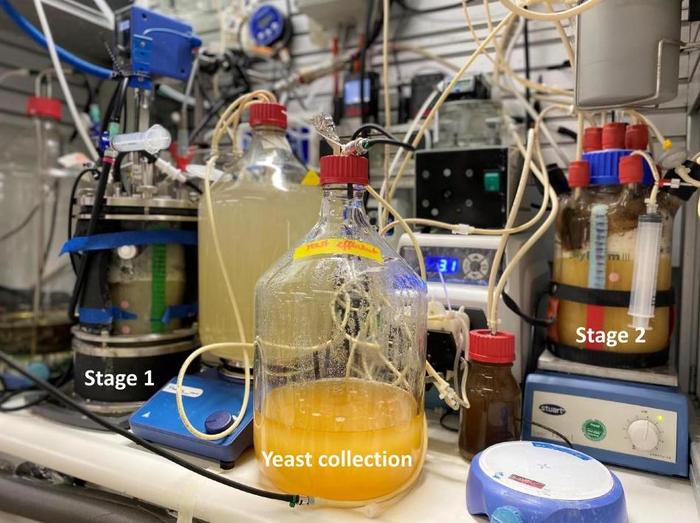Summary: German researchers have developed a two-stage bioreactor system that uses microbes to produce protein and vitamin B9 from CO2, hydrogen, and oxygen, powered by renewable energy.
Estimated reading time: 8 minutes
A team of scientists in Germany has made a significant stride towards sustainable food production by developing a system that converts carbon dioxide (CO2) into protein and vitamins using microbes and renewable energy. This innovative approach, detailed in a study published in the journal Trends in Biotechnology, could potentially address several global challenges, including food security, environmental conservation, and public health.
The research team, led by Largus Angenent of the University of Tübingen, has created a two-stage bioreactor system that produces yeast rich in protein and vitamin B9 (folate). This system operates on a principle similar to beer fermentation but uses gases and acetate instead of sugar to feed the microbes.
How the Bioreactor System Works
The process involves two stages:
- In the first stage, a bacterium called Thermoanaerobacter kivui converts hydrogen and CO2 into acetate (found in vinegar).
- In the second stage, Saccharomyces cerevisiae (baker’s yeast) feeds on the acetate and oxygen to produce protein and vitamin B9.
The hydrogen and oxygen used in this process can be generated through water electrolysis powered by renewable energy sources such as wind power.
Nutrient-Rich Yield
The results of this process are impressive:
- Protein Content: The yeast produced contains higher protein levels than beef, pork, fish, and lentils. Just 85 grams (about 6 tablespoons) of the yeast provides 61% of daily protein needs.
- Vitamin B9: The yeast produces about the same amount of vitamin B9 as sugar-fed yeast. Only 6 grams (less than half a tablespoon) of the dried yeast meets the daily vitamin B9 requirement.
Why It Matters
This technology has the potential to address several critical global issues:
- Environmental Conservation: By using renewable energy and CO2, the system could significantly reduce carbon emissions in food production.
- Food Security: The process could help produce protein and vitamins without relying on traditional agriculture, potentially addressing food scarcity in developing nations.
- Public Health: The high protein and vitamin B9 content could help combat nutritional deficiencies.
- Land Use: By uncoupling food production from land use, this technology could free up space for conservation efforts.
Angenent emphasizes that this technology is not meant to compete with farmers but rather to complement sustainable agriculture: “One alternative is growing proteins in bioreactors through biotechnology rather than growing crops to feed animals. It makes agriculture much more efficient.”
Challenges and Future Steps
While the results are promising, there are still several hurdles to overcome before this yeast-based protein alternative reaches grocery store shelves:
- Optimization and Scale-up: The production process needs to be refined and expanded to industrial scales.
- Food Safety: Comprehensive analysis is required to ensure the product meets all necessary safety standards.
- Economic Viability: Technical and economic analyses are needed to determine the feasibility of large-scale production.
- Consumer Acceptance: Market research will be necessary to gauge public interest in this novel food source.
Additionally, the yeast produced currently contains compounds that could increase the risk of gout if consumed excessively. The researchers note that even after treatment to remove these compounds, the yeast still meets 41% of daily protein requirements, comparable to traditional protein sources.
The Road Ahead
As the global population approaches 10 billion and climate change threatens traditional agriculture, innovative food production methods like this become increasingly crucial. Angenent and his team are optimistic about the potential of their technology:
“The fact that we can make vitamins and protein at the same time at a pretty high production rate without using any land is exciting,” says Angenent. “The end product is vegetarian/vegan, non-GMO, and sustainable, which could appeal to consumers.”
This research represents a significant step towards more sustainable and efficient food production methods. As the technology develops further, it could play a vital role in addressing some of the most pressing challenges facing our planet and its growing population.
Quiz:
- What are the two main stages in the bioreactor system described in the article?
- How much of the yeast produced by this system would provide 61% of daily protein needs?
- What renewable energy source is mentioned as an example for powering the water electrolysis process?
Answer Key:
- Stage 1: Thermoanaerobacter kivui converts hydrogen and CO2 into acetate. Stage 2: Saccharomyces cerevisiae feeds on acetate and oxygen to produce protein and vitamin B9.
- 85 grams or about 6 tablespoons
- Wind power
Further Reading:
Trends in Biotechnology: https://www.cell.com/trends/biotechnology
Microbial Protein Production: https://www.ncbi.nlm.nih.gov/pmc/articles/PMC9818480/
Food Security and Climate Change: https://www.fao.org/climate-change/en/
If our reporting has informed or inspired you, please consider making a donation. Every contribution, no matter the size, empowers us to continue delivering accurate, engaging, and trustworthy science and medical news. Independent journalism requires time, effort, and resources—your support ensures we can keep uncovering the stories that matter most to you.
Join us in making knowledge accessible and impactful. Thank you for standing with us!

